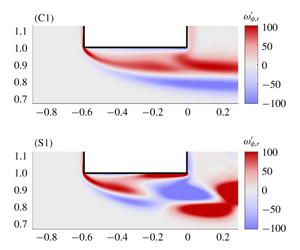Article contents
Acoustic impedance and hydrodynamic instability of the flow through a circular aperture in a thick plate
Published online by Cambridge University Press: 18 December 2019
Abstract

We study the unsteady flow of a viscous fluid passing through a circular aperture in a plate characterized by a non-zero thickness. We investigate this problem by solving the incompressible linearized Navier–Stokes equations around a laminar base flow, in both the forced case (allowing us to characterize the coupling of the flow with acoustic resonators) and the autonomous regime (allowing us to identify the possibility of purely hydrodynamic instabilities). In the forced case, we calculate the impedances and discuss the stability properties in terms of a Nyquist diagram. We show that such diagrams allow us to predict two kinds of instabilities: (i) a conditional instability linked to the over-reflexion of an acoustic wave but requiring the existence of a conveniently tuned external acoustic resonator, and (ii) a purely hydrodynamic instability existing even in a strictly incompressible framework. A parametric study is conducted to predict the range of existence of both instabilities in terms of the Reynolds number and the aspect ratio of the aperture. Analysing the structure of the linearly forced flow allows us to show that the instability mechanism is closely linked to the existence of a recirculation region within the thickness of the plate. We then investigate the autonomous regime using the classical eigenmode analysis. The analysis confirms the existence of the purely hydrodynamic instability in accordance with the impedance-based criterion. The spatial structure of the unstable eigenmodes are found to be similar to the structure of the corresponding unsteady flows computed using the forced problem. Analysis of the adjoint eigenmodes and of the adjoint-based structural sensitivity confirms that the origin of the instability lies in the recirculation region existing within the thickness of the plate.
JFM classification
- Type
- JFM Papers
- Information
- Copyright
- © 2019 Cambridge University Press
References
- 15
- Cited by




